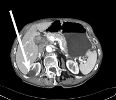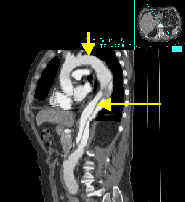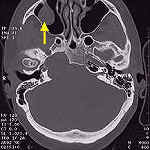Computed Tomography (CT) imaging, also known as "CAT scanning" (Computed Axial Tomography), combines the use of a digital computer together with a rotating x-ray device to create detailed cross sectional images or "slices" of the different organs and body parts such as the lungs, liver, kidneys, pancreas, pelvis, extremities, brain, spine, and blood vessels. For many patients, CT can be performed on an outpatient basis without requiring admittance to the hospital.

Axial CT image of the liver and kidneys shows a benign (non-cancerous) cyst in the right kidney (arrow)
Among the various imaging techniques such as MR and x-ray, CT has the unique ability to image a combination of soft tissue, bone, and blood vessels. For example, conventional x-ray imaging of the head can only show the dense bone structures of the skull. X-ray angiography of the head only depicts the blood vessels of the head and neck and not the soft brain-tissue. Magnetic resonance (MR) imaging does an excellent job of showing soft tissue and blood vessels, but MR does not give as much detail of bony structures such as the skull. CT images of the head allow physicians to see soft-tissue anatomic structures like the brain's ventricles or gray and white matter. Physician then can selectively "window" the digital CT images on the computer monitor to look at the soft tissue, then the bone and then the blood vessels, as needed.

Colored CT image of the brain, purple area on right of image indicates acute stroke
CT is one of the best tools for studying the lungs and abdomen. CT is an invaluable tool in the cancer diagnosis process and is often the preferred method for diagnosing lung, liver and pancreas cancer. CT imaging and CT angiography are finding a greater role in the detection, diagnosis and treatment of heart disease, acute stroke and vascular diseases which can lead to stroke, gangrene or kidney failure. Additionally, CT can be used to measure bone mineral density for the detection of osteoporosis. CT has excellent application in trauma cases and other emergencies. All dedicated shock-trauma centers have a CT scanner in the trauma department so patients can be immediately scanned to scout for major internal injuries such as aortic aneurysm (see image below) or other internal bleeding.

Sagittal multiplanar reconstructed CT image of the thorax and abdomen showing an aortic aneurysm. The aorta (short arrow) looks like a white "candy-cane" in the middle of this image. The aneurysm (long arrow) is the thin line running through the candy cane.
CT is used extensively for diagnosing problems of the inner ears and sinuses because of its ability to generate very high resolution images. The anatomy of the inner ear and sinuses is made up of delicate soft tissue structure and very fine bones. CT is excellent for imaging tumors or polyps in the sinuses and disease that cause degeneration of the small bones in the inner ear.

High resolution axial CT image of the inner ears and sinuses. A large polyp in the right sinus (arrow) can be seen
CT can provide detailed cross sectional images and diagnostic information for nearly every part of the body including:
- the brain, vessels of the brain, eyes, inner ear, sinuses
- the neck, shoulders, cervical spine and blood vessels of the neck
- the chest, heart, aorta, lungs, mediastinum
- the thoracic and lumbar spine
- the upper abdomen, liver, kidney, spleen, pancreas and other abdominal vessels
- the pelvis and hips, male and female reproductive system, bladder, and GI tract
- the skeletal system including bones of the hands, feet, ankles, legs and arms, and jaws



